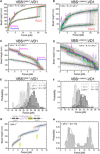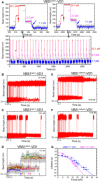Direct single-molecule quantification reveals unexpectedly high mechanical stability of vinculin-talin/α-catenin linkages
- PMID: 31897422
- PMCID: PMC6920023
- DOI: 10.1126/sciadv.aav2720
Direct single-molecule quantification reveals unexpectedly high mechanical stability of vinculin-talin/α-catenin linkages
Abstract
The vinculin-mediated mechanosensing requires establishment of stable mechanical linkages between vinculin to integrin at focal adhesions and to cadherins at adherens junctions through associations with the respective adaptor proteins talin and α-catenin. However, the mechanical stability of these critical vinculin linkages has yet to be determined. Here, we developed a single-molecule detector assay to provide direct quantification of the mechanical lifetime of vinculin association with the vinculin binding sites in both talin and α-catenin, which reveals a surprisingly high mechanical stability of the vinculin-talin and vinculin-α-catenin interfaces that have a lifetime of >1000 s at forces up to 10 pN and can last for seconds to tens of seconds at 15 to 25 pN. Our results suggest that these force-bearing intermolecular interfaces provide sufficient mechanical stability to support the vinculin-mediated mechanotransduction at cell-matrix and cell-cell adhesions.
Copyright © 2019 The Authors, some rights reserved; exclusive licensee American Association for the Advancement of Science. No claim to original U.S. Government Works. Distributed under a Creative Commons Attribution NonCommercial License 4.0 (CC BY-NC).
Figures



Similar articles
-
Force-dependent vinculin binding to talin in live cells: a crucial step in anchoring the actin cytoskeleton to focal adhesions.Am J Physiol Cell Physiol. 2014 Mar 15;306(6):C607-20. doi: 10.1152/ajpcell.00122.2013. Epub 2014 Jan 22. Am J Physiol Cell Physiol. 2014. PMID: 24452377
-
α-Catenin uses a novel mechanism to activate vinculin.J Biol Chem. 2012 Mar 2;287(10):7728-37. doi: 10.1074/jbc.M111.297481. Epub 2012 Jan 10. J Biol Chem. 2012. PMID: 22235119 Free PMC article.
-
A mechanism of mechanotransduction at the cell-cell interface: emergence of α-catenin as the center of a force-balancing mechanism for morphogenesis in multicellular organisms.Bioessays. 2011 Oct;33(10):732-6. doi: 10.1002/bies.201100064. Epub 2011 Aug 9. Bioessays. 2011. PMID: 21826690 No abstract available.
-
Vinculin in cell-cell and cell-matrix adhesions.Cell Mol Life Sci. 2017 Aug;74(16):2999-3009. doi: 10.1007/s00018-017-2511-3. Epub 2017 Apr 11. Cell Mol Life Sci. 2017. PMID: 28401269 Free PMC article. Review.
-
New insights into vinculin function and regulation.Int Rev Cell Mol Biol. 2011;287:191-231. doi: 10.1016/B978-0-12-386043-9.00005-0. Int Rev Cell Mol Biol. 2011. PMID: 21414589 Free PMC article. Review.
Cited by
-
Vinculin transmits high-level integrin tensions that are dispensable for focal adhesion formation.Biophys J. 2023 Jan 3;122(1):156-167. doi: 10.1016/j.bpj.2022.11.013. Epub 2022 Nov 9. Biophys J. 2023. PMID: 36352785 Free PMC article.
-
Force-Dependent Structural Changes of Filamin C Rod Domains Regulated by Filamin C Dimer.J Am Chem Soc. 2023 Jul 12;145(27):14670-14678. doi: 10.1021/jacs.3c02303. Epub 2023 Jun 27. J Am Chem Soc. 2023. PMID: 37369984 Free PMC article.
-
Single-molecule force stability of the SARS-CoV-2-ACE2 interface in variants-of-concern.Nat Nanotechnol. 2024 Mar;19(3):399-405. doi: 10.1038/s41565-023-01536-7. Epub 2023 Nov 27. Nat Nanotechnol. 2024. PMID: 38012274
-
Interdomain Linker Effect on the Mechanical Stability of Ig Domains in Titin.Int J Mol Sci. 2022 Aug 30;23(17):9836. doi: 10.3390/ijms23179836. Int J Mol Sci. 2022. PMID: 36077234 Free PMC article.
-
A loosened gating mechanism of RIG-I leads to autoimmune disorders.Nucleic Acids Res. 2022 Jun 10;50(10):5850-5863. doi: 10.1093/nar/gkac361. Nucleic Acids Res. 2022. PMID: 35580046 Free PMC article.
References
-
- Vogel V., Sheetz M., Local force and geometry sensing regulate cell functions. Nat. Rev. Mol. Cell Biol. 7, 265–275 (2006). - PubMed
-
- Borgon R. A., Vonrhein C., Bricogne G., Bois P. R. J., Izard T., Crystal structure of human vinculin. Structure 12, 1189–1197 (2004). - PubMed
-
- Xu W., Baribault H., Adamson E. D., Vinculin knockout results in heart and brain defects during embryonic development. Development 125, 327–337 (1998). - PubMed
Publication types
MeSH terms
Substances
LinkOut - more resources
Full Text Sources
Miscellaneous

